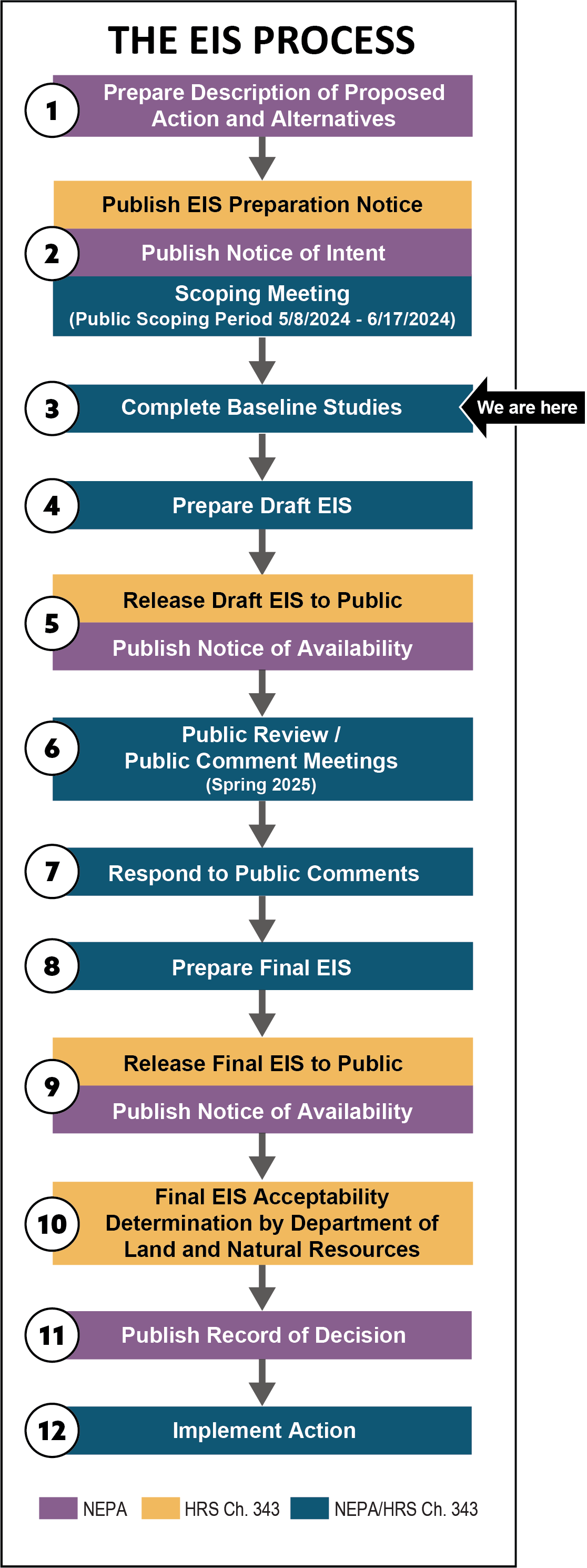National Environmental Policy Act, Hawai‘i Revised Statutes Chapter 343, and National Historic Preservation Act Section 106
Pacific Missile Range Facility and Kōkeʻe Park Geophysical Observatory Real Estate Environmental Impact Statement

In this section
Pacific Missile Range Facility and Kōkeʻe Park Geophysical Observatory Real Estate Environmental Impact Statement
The Navy and NASA are jointly preparing an Environmental Impact Statement (EIS) pursuant to the National Environmental Policy Act (NEPA). The EIS will also be used by the Hawai‘i Department of Land and Natural Resources under Hawai‘i Revised Statutes (HRS) Chapter 343 and Hawai‘i Administrative Rules Chapter 11-200.1, collectively referred to as the Hawai‘i Environmental Policy Act (HEPA), in its decision making as to whether and what type of real estate agreement it may grant the Navy and NASA.
The EIS Process diagram (right) illustrates the stages of public involvement in the NEPA and HEPA environmental processes. The public involvement processes for NEPA and HEPA for this EIS are running concurrently to meet the requirements for both state and federal laws and regulations.
The NEPA/HEPA scoping meetings served as an opportunity to obtain public input concerning potential effects to historic properties pursuant to Section 106 of the National Historic Preservation Act (NHPA) and HRS Section 6E-42.
To learn more about the HEPA process, visit the State of Hawai'i Office of Planning and Sustainable Development Environmental Review Program website.
COMMUNITY INVOLVEMENT
The Navy and NASA initiated a public scoping process to receive comments on the scope of the EIS. Members of the public were encouraged to participate in the environmental planning process by providing input on the proposed real estate action including potential alternatives, environmental or cultural concerns, information the public would like the Navy and NASA to know, and any other information the public would like to see addressed in the EIS, and the project’s potential to affect historic properties pursuant to Section 106 of the NHPA and HRS Section 6E-42.
The Navy and NASA conducted comprehensive community outreach on the potential environmental impacts of the Proposed Action. The Navy and NASA are proud contributing members to the local community. The Navy and NASA value and welcome input from the community, as well as the chance to share, communicate, and inform the community about the EIS and the need for the real estate agreements.
Opportunities for formal public participation in the EIS process occur during two stages:
WHAT IS SCOPING?
Scoping occurs at the beginning of the NEPA/HEPA process to help the Navy and NASA understand community-specific concerns regarding the Proposed Action and the planned analysis. Scoping encourages the participation of other federal, state, and local agencies, Native Hawaiian Organizations, environmental, cultural, and other groups, and the general public. Scoping helps determine what should be studied in this EIS including the alternatives to be analyzed.
